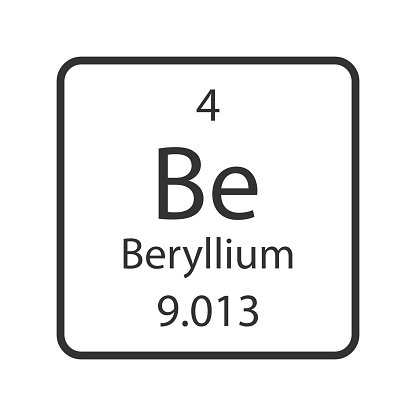Beryllium is a chemical element with the symbol Be and atomic number 4. It is a rare and highly toxic metal that is lightweight, strong, and has a high melting point. Beryllium is one of the lightest metals and has a density of only 1.85 g/cm³, which is less than one-third the density of steel.


Physical properties of beryllium
Beryllium is a rare and highly toxic metal that has some unique physical properties, including:
- Low density: Beryllium is one of the lightest metals, with a density of only 1.85 g/cm³. This makes it useful in applications where weight is a concern.
- High melting point: Beryllium has a very high melting point of 1,287°C, which makes it useful in high-temperature applications.
- High stiffness: Beryllium is one of the stiffest materials known, and it has a modulus of elasticity that is about 30% higher than that of steel. This property makes it useful in applications where high stiffness and low weight are required.
- Low thermal expansion: Beryllium has a very low coefficient of thermal expansion, which means it doesn’t expand or contract much when subjected to changes in temperature. This makes it useful in applications where dimensional stability is important.
- Good electrical conductivity: Beryllium is a good conductor of electricity, and it is often used as an electrical contact material.
- Reflectivity: Beryllium has a high reflectivity for X-rays and other forms of ionizing radiation, which makes it useful in X-ray equipment and other scientific applications.
Overall, beryllium has some unique physical properties that make it useful in a variety of applications, particularly those that require low weight, high stiffness, and high-temperature performance. However, its toxicity requires careful handling and safety measures.
Сhemical properties of beryllium
Beryllium is a highly reactive metal with some unique chemical properties:
- Oxidation: Beryllium readily reacts with oxygen in air, forming a thin oxide layer on its surface that protects it from further oxidation.
- Reactivity: Beryllium is highly reactive with acids, bases, and many other chemicals. It readily dissolves in dilute acids such as hydrochloric acid and sulfuric acid, producing beryllium salts and hydrogen gas.
- Electronegativity: Beryllium has a relatively high electronegativity for a metal, which means it tends to form covalent bonds with nonmetals rather than ionic bonds with other metals.
- Stability: Beryllium is relatively stable in air and water, but it is highly reactive with other elements, particularly halogens and nonmetals.
- Toxicity: Beryllium is highly toxic, and its compounds can cause lung damage and cancer if they are inhaled or ingested. This toxicity makes beryllium a dangerous material to handle, and strict safety measures are required when working with it.
- Complex chemistry: Beryllium has a complex chemistry, with a variety of oxidation states and coordination geometries. Its small size and high charge density make it unique among the metals and give rise to many of its unusual properties.
Overall, beryllium has some unique chemical properties that make it both useful and dangerous. Its reactivity and toxicity require careful handling and safety measures, but its unique properties also make it useful in a variety of industrial and scientific applications.
Isotopes of beryllium
Beryllium has two stable isotopes, 9Be and 10Be, and a number of unstable isotopes, which are radioactive and decay into other elements.
The most common isotope of beryllium is 9Be, which makes up about 100% of naturally occurring beryllium. It has four protons, five neutrons, and four electrons.
The second stable isotope of beryllium is 10Be, which makes up only about 0.01% of naturally occurring beryllium. It has four protons, six neutrons, and four electrons. 10Be is formed in the atmosphere by the interaction of cosmic rays with oxygen and nitrogen atoms, and it is used in a variety of scientific applications, such as dating the age of rocks and studying the history of climate change.
In addition to these stable isotopes, beryllium has a number of radioactive isotopes, including 7Be, 8Be, 11Be, and others, which have half-lives ranging from fractions of a second to several million years. These isotopes are typically produced in nuclear reactors or particle accelerators, and they are used in a variety of scientific and medical applications, such as radiation therapy for cancer treatment. However, they are also highly toxic and require careful handling and safety measures.
Application of beryllium
Beryllium has some unique properties that make it useful in a variety of industrial and scientific applications, including:
- Aerospace industry: Beryllium is used in aerospace applications because of its low density and high stiffness. It is often used in structural components, mirrors for telescopes, and satellite parts.
- Nuclear industry: Beryllium is used in the nuclear industry as a neutron reflector and moderator. Its high thermal conductivity and low atomic number make it ideal for use in nuclear reactors and other applications that involve nuclear reactions.
- X-ray windows: Beryllium is transparent to X-rays and other forms of ionizing radiation, making it useful as a window material in X-ray equipment and other scientific instruments.
- Electronics industry: Beryllium is used as a dopant in semiconductors, which are used in electronic devices such as transistors and diodes. It is also used as a contact material in electronic connectors and switches.
- Defense industry: Beryllium is used in various military applications, including missile guidance systems, nuclear weapons, and armor plating.
- Medical applications: Beryllium is used in some medical applications, such as radiation therapy for cancer treatment. It is also used in some dental alloys and in some medical imaging equipment.
Despite its usefulness, beryllium is a highly toxic material, and strict safety measures are required when working with it to prevent inhalation or ingestion of beryllium dust or fumes.